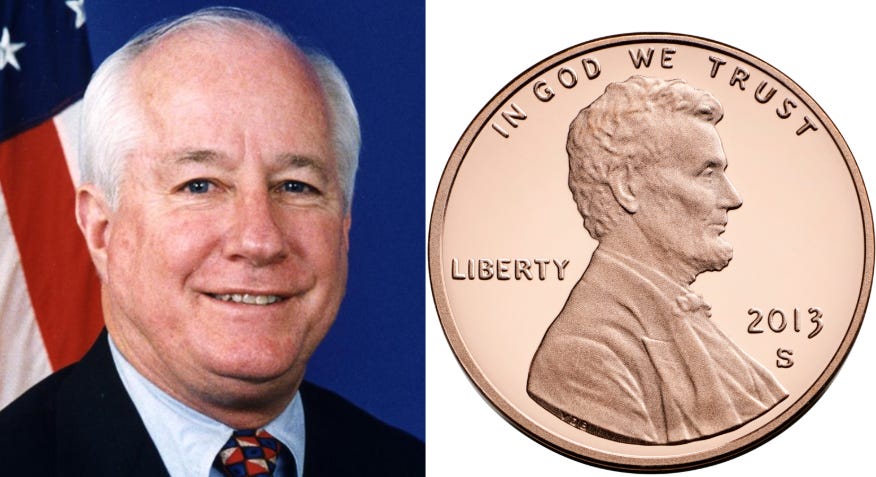The Penny Finally Drops
Small change means little
James Thomas Kolbe died in 2022. He was eighty years old and retired after representing Arizona in the US House for 22 years. A moderate Republican, and openly gay, Kolbe did not live long enough to see his most famous pet project become reality when the U.S. Mint in Philadelphia stopped minting pennies last Wednesday.
From now on, stores will gladly accept your pennies, but will not be giving them out as change. All cash transactions will be rounded to the nearest nickel. What would impress Kolbe most, I think, is that these changes, which he first proposed in his Price Rounding Act of 1989, are happening without any public resistance at all.
Americans have used debit cards for a generation, and used their phones as wallets for a decade. Today, a substantial majority of us seldom use cash for in-store transactions anymore. ‘Tap to pay’ is faster and more convenient than cash, while digital ‘point of sale’ systems have become ubiquitous. We are a different nation, no longer pinching our pennies, even to save money.
The penny problem starts with your coin jar. We hoarded pennies too much because they were so low in value. Carrying the jar to the store would be too difficult, so we never spent them, and nobody wanted them from us. Even the bank required us to put them in rolls first. It cost too much energy to spend our pennies, so we left them in the jar. We did not circulate them. Pennies have existed to give us change so that we do not feel cheated, they have never been change for us to spend.
A problem penny is also probably lying outside the front door of your nearest gas station. When I was a child in 1980, a few pennies could still buy a piece of candy, so I never hestiated to pick one up off the ground. Quarters are still far more useful than pennies even today, so we find them on the pavement much less often. However, the amount of discarded pennies on the ground has observably increased in my lifetime as the value and utility of pennies declined.
Homeless people walk past pennies on the ground, anymore, for they are not worth stooping over to pick up. They are too heavy, take up too much space in one’s pocket or wallet. Pennies are inconvenient; at some point, the inconvenience costs more than the value of the coin, just as the government has spent 3.7 cents to mint each penny because they were a convenience. Many European states had already stopped making penny equivalents by the end of the 1980s for these same reasons.
In 1989, the zinc lobby created Americans for Common Cents (ACC) to oppose Kolbe’s proposed legislation. Charities were concerned they would receive fewer donations from consumers, especially the Salvation Army, which helps consumers unburden themselves of change on their way out of stores at Christmastime. Polling showed that most Americans were still in favor of keeping the penny, so the bill languished in committee.
However, a research initative began as the digital revolution arrived in American retail businesses. When the Goverment Accounting Office studied the penny question in 1996, they found public opinion was now “mixed”, for “while over half of the people would prefer rounding to using pennies, a similar percentage also believe the penny is useful and should be retained.” Americans both loved and hated the penny. While on the one hand, “59 percent of respondents said the penny was useful” in the GAO survey, “52 percent of respondents preferred that prices be rounded to the nearest nickel”.
Pennies were already not circulating nearly as much as quarters. Yet each penny held only 70 percent of the value of the cost to mint it, a ratio that has drastically worsened since the GAO report. A convenience to the American consumer was becoming inconvenient to the American taxpayer.
Still, there were dangers: if everyone turned in all their pennies all at once, “negative seigniorage could result from the return of pennies if existing money were given to the public in exchange.” That is, if every American went right to the bank with their coin jars to get dollars for their pennies, the costs of suddenly taking in billions of pennies for scrap might overwhelm the Federal Reserve and the U.S. Mint. The overall impact of giving up the penny would be negligibile.
The GAO report also highlighted an experiment in penny-dropping conducted on the Americans deployed to NATO countries. Not only had they accepted the new system, it had not broken the on-base economy in Europe. Instead, everything ended up exactly the way it is all supposed to work right now, per President Trump’s executive order.
In 1990, we reported that, in 1980, the U.S. Army in Europe asked the American military facilities in Europe to eliminate the penny because of the expense of transporting the coins there. All but three facilities — the Post Office, the commercial bank, and the Finance Office — agreed to the change. These three facilities were bound by regulations that would not allow them to round prices. The commissaries and Army and Air Force Exchange Service facilities welcomed the coin’s elimination and said that they were not adversely affected by it. Officials said that, while a few complaints were received initially, as customers became familiar with the rounding policy, complaints decreased and then were rarely received. However, officials said that the facilities often rounded down to minimize complaints. Also, we reported that, while the facilities did not give pennies as change, they accepted pennies if people wanted to pay with them.
Kolbe reintroduced legislation, the Legal Tender Modernization Act, to end penny minting in 2001. One year later, he had made no progress, but his efforts were leaving traces on the newfangled internet. Online commerce was thriving even if the ‘dotcom bubble’ had burst. Kolbe kept fighting, patient, sure that change was coming, pun intended.
Within a decade, the Great Recession would have everyone looking for ways to pinch pennies. Barack Obama was willing to do away with them “if we can find another place for Lincoln to land.” Congress told the U.S. Mint to research cheaper materials than zinc.
Jim Kolbe had retired from Congress in 2007. Still, this time there was better-organized advocacy against the penny, while the advocates for keeping pennies used the same arguments as before. The zinc lobby was keenly interested in the welfare of America’s poorest, who used the penny most, they said. Robert Whaples, chairman of Wake Forest University’s economics department, favored the ‘no penny’ movement, but worried “emotional attachment” to pennies would prevent lawmakers “from doing a sensible thing.” His worries proved correct.
Covid was the next inflection point. Lockdown created a shortage of pennies in the cash economy by shutting down the U.S. Mint in 2020. Since then, a series of reported local penny shortages around the nation has forced retail businesses that still use lots of pennies, such as McDonald’s and Kroger stores, to make the ‘nickel shift’. The practice became more widespread after the Trump EO, a byproduct of the brief DOGE era in his administration. Rather than resist, the retail industry is pleading for Washington to give them specific policy directives.
Today, the ‘penny drop’ is happening nationwide, and it is going down exactly like it did on America’s European military bases. “They do be surprised,” one Piggly Wiggly cashier said in Georgia this week. “They be looking at their change and I be like, ‘We don’t have ‘em.’” Told that the pennies have run out, customers just accept it. They don’t complain. Contrary to what the defenders of the penny have always claimed, the penny was never really popular except among coin collectors.
People simply don’t like being short-changed. This was the “emotional attachment” that Professor Whaples mentioned, the enemy with which Jim Kolbe had to contend almost 37 years ago when he began his penny crusade. This barrier has finally been overcome by our better sense, thanks to the training of our technology and inflationary pressure on the penny. The penny has dropped: we are already over the penny coin. We have always been over it, and now that it is gone we are not going to miss it.
A Spiritual Biography Of The Flying Saucer
Next month will complete the first ‘volume’ of audio readings of my essay series on the history of the belief in extraterrestrials. Each essay is linked below with the audio reading on YouTube. Audio of the Heaven’s Gate essay linked at the bottom of this post will be published on the channel in December.



